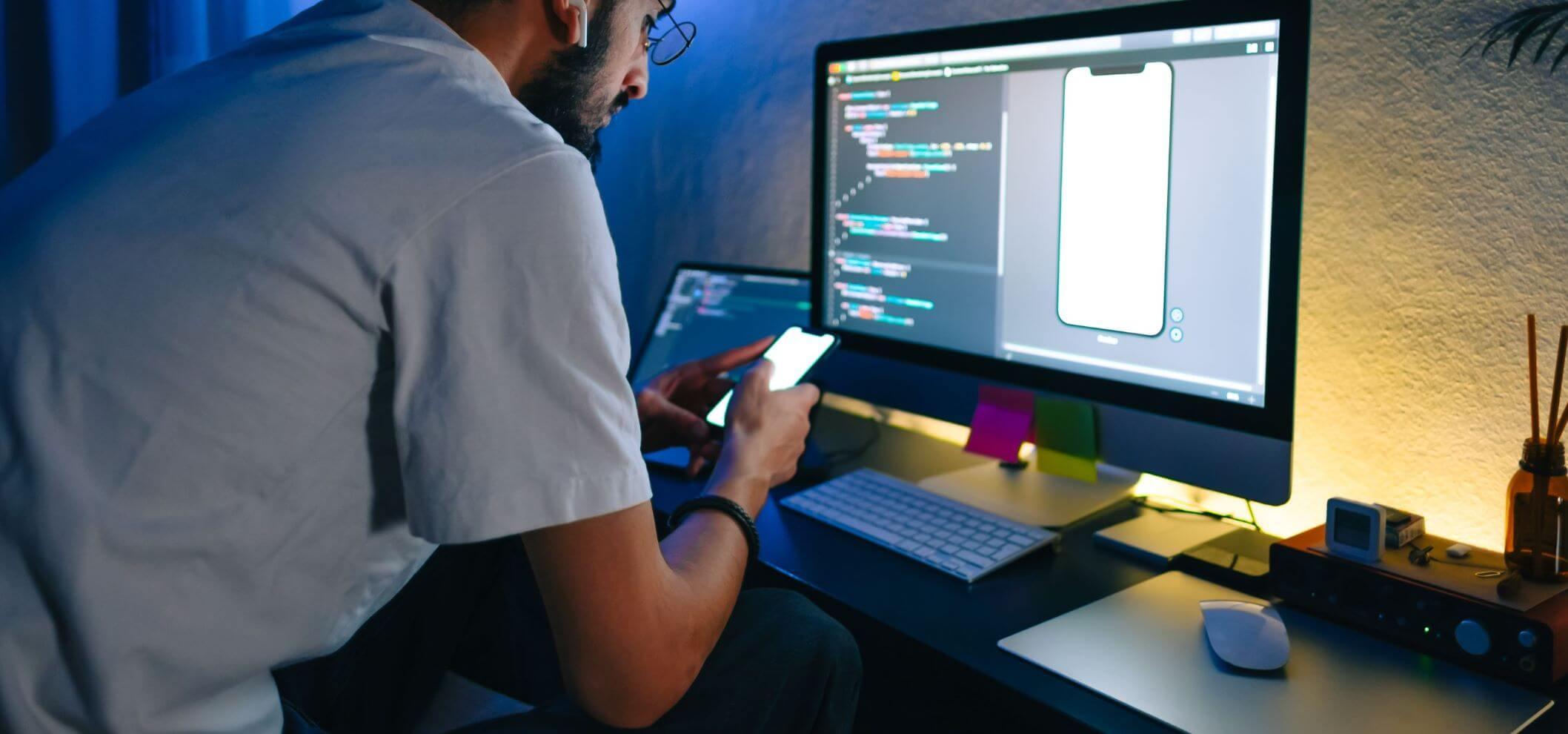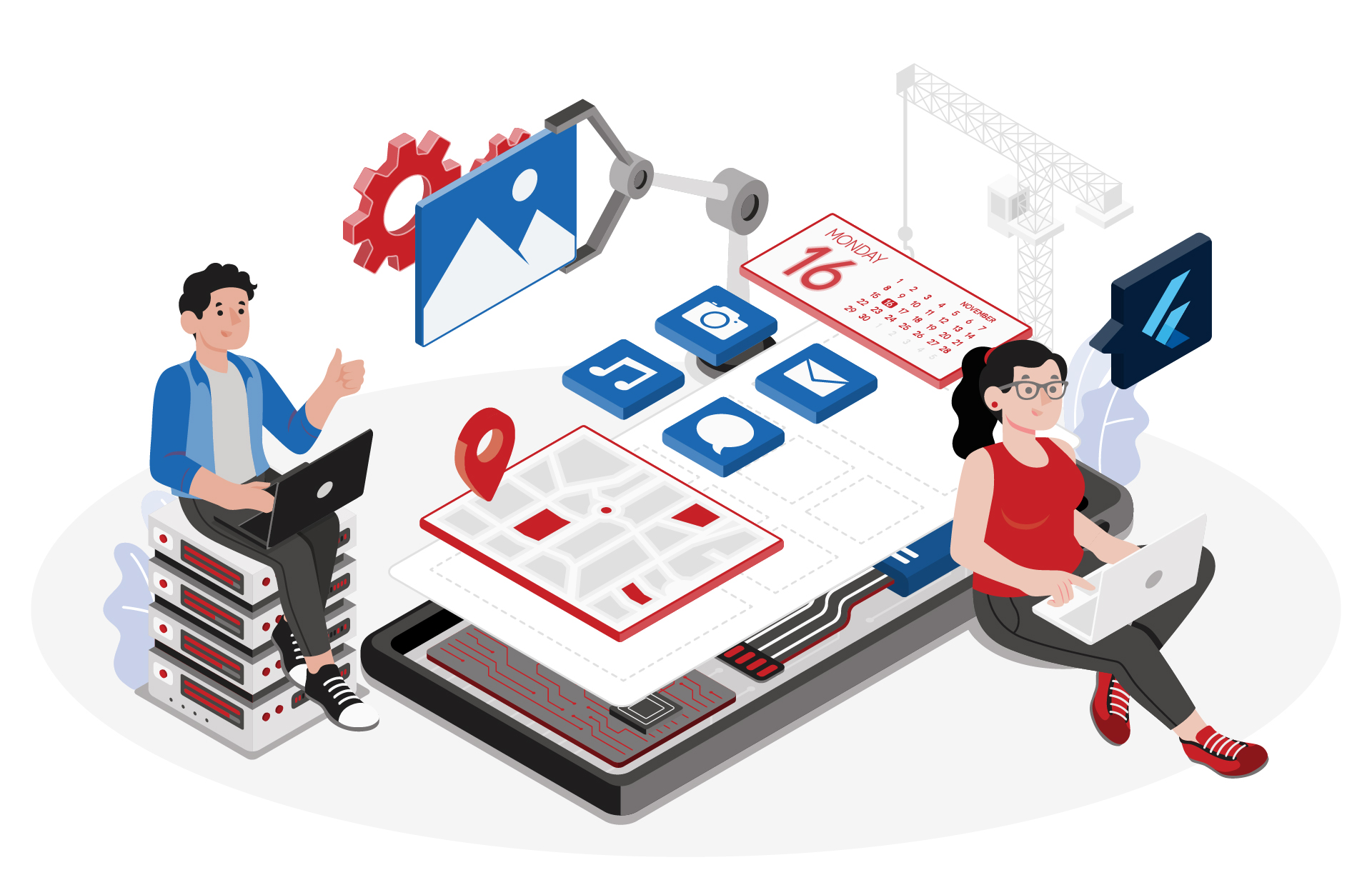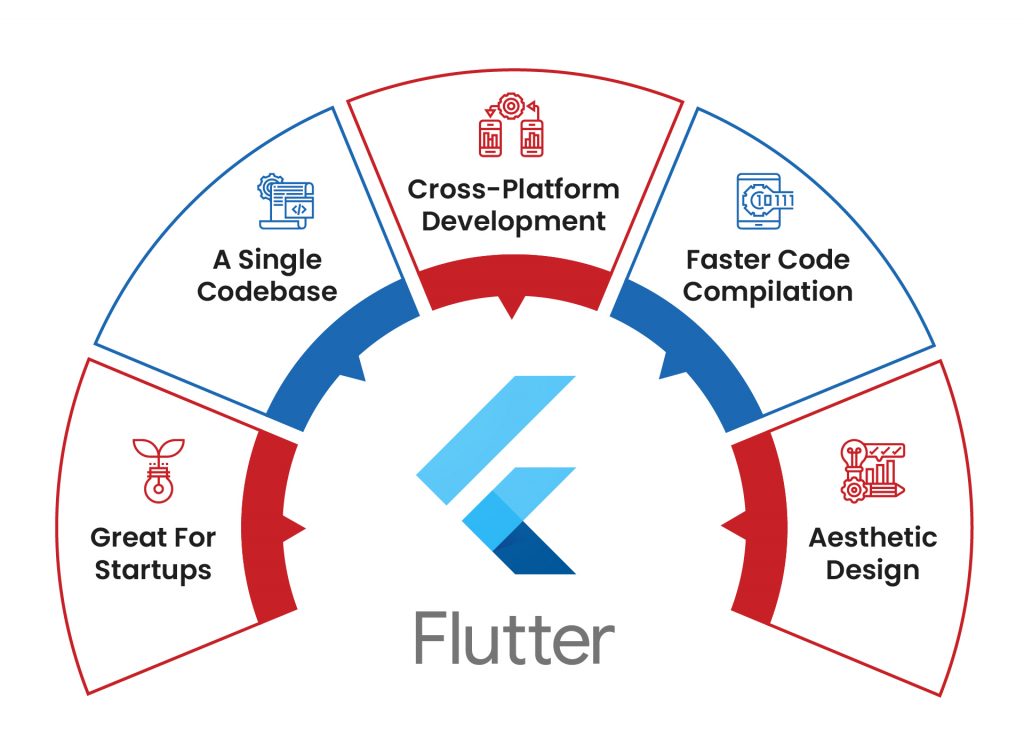
What Is Flutter App Development? Here’s Everything You Need To Know
Julian Wallis
12 min read

With Flutter, you can build, test, and deploy impressive mobile apps from a single codebase — and it wouldn’t be an exaggeration to say that this new platform has transformed the entire app development process.
In this article, we discuss what Flutter app development is, its features and benefits, how it works and why you might choose it for your next mobile app project.
Welcome To The World of Mobile App Development 🚪
With the rise in technology and availability of resources, many app startups have emerged in recent years. It’s obvious that this decade has seen exponential growth for their markets as well, and the upcoming years will be full steam ahead with innovations coming out every month, which means you can bet your bottom dollar that there’s going to be something waiting just around the corner (or on our phones)!
If you have been thinking of getting into the app development game yourself, there has never been a lower barrier to entry. There’s little excuse for not being able to create a solution for your business requirements by leveraging the new tools and technologies available today — not to mention some of the best developer-friendly platforms that you can now use for mobile app development, i.e., from React Native to Flutter.
If you have been eyeing Flutter as a potential mobile app development platform for your company or clients, this post is for you! In it, we’ll take a look at everything you need to know about Flutter — what it is, how it works, and what its benefits are.
Flutter — What’s That? 🤔
These days, developers rely on an innovative language packed with a robust mobile framework: Flutter — a platform with which you can build apps for any device of any screen size!
Flutter is a hot new app development framework that’s quickly becoming one of the most popular among developers. With over 100k stars on GitHub and support from Google, Flutter makes it a lot easier to build iOS or Android apps without frustrating compatibility headaches!

As a software development kit (SDK), Flutter helps you build apps that look and function like native ones. The platform has been around since 2015, when Google first created it — and was later officially launched in 2018. Though still a relatively new technology, the buzz around Flutter has been growing exponentially louder ever since!
So What Exactly Is Flutter? 🤷♂️
Flutter is a robust mobile app development framework that can be used to create cross-platform apps for iOS, Android, and Windows. It uses Google’s Dart programming language, and it comes with its own graphics library and material design, allowing faster app development and a more polished finished product.
The basic idea behind Flutter is using widgets — and by combining different widgets, developers can build a complete user interface (UI). Think of widgets as a structural element (like a button or a menu) or a stylistic element (font or colour scheme). Flutter provides developers with ready-made widgets that look native.
Flutter comprises two essential components.
- A software development kit (SDK) — a collection of tools that will help your developers compile coding into native machine code (for iOS and Android).
- A framework or widgets-based UI library — a collection of UI elements that developers can use to customise and personalise the application.
Supported and used by Google and trusted by well-known brands worldwide, from eBay to Toyota, Flutter’s ecosystem is stable and reliable. In addition, from the developers’ perspective, the platform is supported by Android Studio and VS Code — two lightweight code editors and tools that make everything configurable.
To avoid performance issues, the platform uses Dart by compiling it ahead of time into the native code for multiple platforms, enhancing the application start-up time. Interestingly, Flutter is the only mobile SDK that offers a reactive view without the need for JavaScript code — and because of that, many developers have been favouring Flutter on their app development projects.
What’s So Good About Flutter? 🎯
Flutter is a free and open-source mobile UI framework. Developers only need to use one programming language and one codebase to create apps for all platforms!
In addition, there are several advantages of using Flutter for app development:
❄️ Cross-Platform Development
Flutter allows you to create cross-platform apps, meaning you only need to write the code once, and it will work on both iOS and Android devices — and even production-level Windows apps as of now!
Cross-platform development means you can write your code once and run it across multiple platforms, which definitely makes developers’ lives easier! Cross-platform frameworks have been around for some time now — although they have struggled to deliver the quality of apps for both iOS or Android platforms that Flutter is able for.
That said, though, when talking about Flutter vs React Native or any other development framework … Most developers would agree that there is very little competition with Flutter.
❄️ Faster Code Compilation
Flutter is fast — Flutter code complies with ARM or Intel machine code and JavaScript for speedy performance on any device. You can change the code and see the results in real-time, thanks to a feature called hot reload — a great way to make changes and see the effect immediately. This saves you time when designing apps, adding features, or fixing bugs in your application’s code!
With Flutter, you can deliver apps that work on all the latest devices in a fraction of its time using native platform development. Or suppose your budget is limited, yet you require more features for the app. In that case, this is made possible as cost-effectively delivering more with less wasn’t really feasible when building apps on native platforms due to their complexity.
❄️ Aesthetic Design
Flutter’s graphics library and aesthetic design make developing attractive and functional apps easier.
Widgets help libraries make it possible to build UIs using widgets and compose them together. You can think of the UI components as building blocks that describe what your application looks like, much in line with how material design specifications are made up of various smaller modules under one roof — but this time around, there’s your very own custom design!

Flutter offers an extensive set of widgets, closely matching iOS counterparts, even featuring high fidelity replicas right down onto each component.
❄️ A Single Codebase
With a single codebase, you can reach users on every screen, from mobile to web to desktop devices. Due to the faster code compilation from a single place, here’s what you can do with Flutter:
- You can put your entire business logic and code in a single location,
- You can deliver apps with the same features across all platforms, and
- You can plan the testing and Q/A as needed.
Flutter is open source, meaning the code is freely available for anyone to use and adapt. You can collaborate on the open-source framework, contribute to the package ecosystem on flutter.dev, and find help from community support.
❄️ Great For Startups!
The platform is ideal for start-ups who want to create a minimal viable product (MVP) as quickly as possible and show it to the investors or internal teams!
Besides, Flutter is simple to learn and use compared to Java or React Native. Without relying too much on code, you can build a native-looking app with the help of widgets. In turn, you can control your workflow with automated testing, developer tools, and frameworks you need to build production-quality apps!
Is Flutter the Right Choice For You? 💭
Flutter is an excellent choice for mobile app development projects of all sizes. It is particularly well-suited to creating high-quality UI designs and animations that work across multiple platforms. However, it can also be used for more complex applications that require heavy data processing.
The great thing about Flutter is the relatively smooth learning curve. Because of the excellent documentation — along with the detailed examples, try-it-out codes, and primary use cases — developers that are new to the framework can get up to speed quickly. For instance, if they get stuck with a widget in their code, they can use the documentation to find the solution.
Flutter might not be the right choice for you if you lack a team of developers who are well versed in Dart — or if they rely too much on third-party libraries and frameworks.
You need to be mindful that as Flutter is still somewhat a newer platform, it doesn’t have hundreds of third-party libraries and widgets. Although Dart is an easy to learn, fast and object-oriented programming language, it is still not as popular as its peers, such as JavaScript or Python. Not many developers are well versed with Dart compared to other programming languages.
Though Flutter comes with relatively limited support and use cases, this limitation will likely be overcome in the future, as the community and resources are growing even as we speak!
Flutter Pricing — How Much Does It Cost? 💸
The cost of developing a mobile app depends not just on one factor but also on many different factors. The three most essential elements that determine the overall price tag for your project are discovery cost, deployment charge, and development time (which can vary depending upon what stage your developers are at).
The good news is Flutter is free to download and use; however, your developers need a developer licence to create commercial apps. The developer’s licence is intended to encourage software developers and computer programmers in using the capabilities of commercial software offerings, which can be built up as an ecosystem around them.
Since it’s open-source, a team of developers with expertise can get started to build, preview, and run the apps. Besides, they also get the functionality to deploy apps in the AppStore or PlayStore — not to mention custom APIs and GitHub integration. Here, you’ll have to keep in mind that developer costs vary depending on the number of hours they contribute or whether they freelance or are a part of your in-house team.
Once your team has developed your Flutter app, it’s time to publish them in the stores. The two most popular deployment platforms are Google PlayStore and Apple AppStore. These platforms, however, charge a fee.
- Google Play – $35 one time fee
- AppStore – $135 renewed annually; $410 for expertise version
Moreover, the stores take 30% of every in-app purchase your application makes.
The best thing about Flutter is it reduces the overall development cost significantly as the app developers can reuse the code and make their work more efficient with a single codebase. In addition, it saves time in the maintenance of apps since there is no need for multiple languages or platforms — and everything is open-source and almost free!
Some Real-Life Use Cases 👇
Flutter has a stunning UI that provides almost a native-like feeling. Developers can also save time and resources on development and achieve similar results when working with Flutter. That’s why many companies around the world have chosen Flutter as their trusted mobile application development framework.
For example, eBay Motors, one of the major products of eBay, has been built with Flutter. Users can buy and sell vehicles by using this app — and with just a few taps, they can browse offers, post adverts, and bid for offers they like.
Other examples of applications built with Flutter include but are not limited to Stadia, Google Ads, Google Assistant, Xianyu app of Alibaba Group, The New York Times mobile app, and so on.
On our side, we have also used Flutter to build a SaaS product called Trackify, which is a leading heavy vehicle accreditation and fleet management software app that makes paperless heavy vehicle accreditation easy. Besides that, we’re constantly working with clients to build mobile applications for their businesses using Flutter!
Best Resources For Learning Flutter 📚
The best way to learn Flutter is to find a good tutorial from someone experienced, professional, and highly competent in Flutter — and follow it step-by-step. And what’s better than relying on the developer documentation from Flutter’s official website?
In the developer portal, your developers can find guides to getting started, widget catalogues, API documentation, sample codes, and video tutorials. The Boring Flutter Show, available on YouTube, is an excellent resource for beginners and seasoned programmers, especially those who like to learn through videos!
Moreover, there are several excellent online tutorials, such as this one from Google. If you like to learn something new the old school way — that is by reading textbooks! — you can check out Beginning Flutter: A Hands-On Guide to App Development, that’s available both in paperback and Kindle versions.
In addition, the Common Flutter Errors page has been an excellent resource for developers who are struggling with some of the common errors they may encounter while working on projects using this framework. Future revisions will continue to add new errors and provide ways developers can resolve them. Hence, developers can open an issue or submit pull requests if anything specific needs updating!
Concluding Thoughts 👍
With a single codebase, you can build beautiful iOS and Android apps with Flutter. But what about web applications? The Flutter technology team is investing heavily into desktop support — and it will only be a matter of time before this full vision for the product is realised!
Well, this article is a fair amount of what you need to know about Flutter to get started! The bottom line is that it’s a robust framework that can create impressive and functional mobile apps for iOS and Android devices.
If you are thinking of starting a new app development project for yourself or your company, Flutter is undoubtedly worth considering. If you’d like more information on the Flutter mobile app development process, please contact us here for an obligation-free chat about your project. We’re always ready to help you in your development journey, no matter what stage you’re at.
Topics
Published On
March 07, 2022

